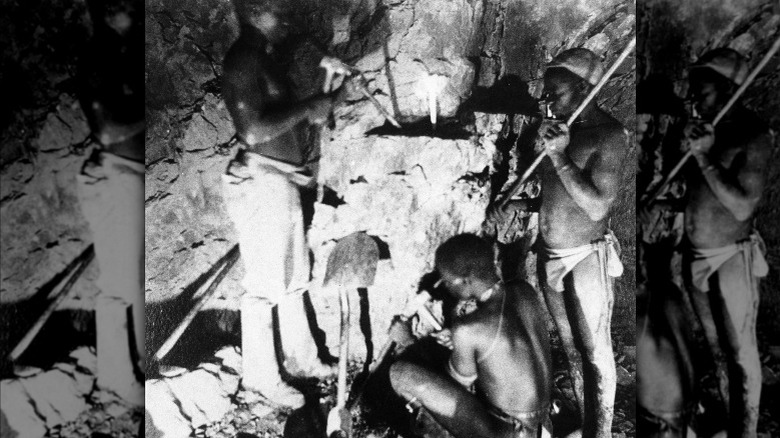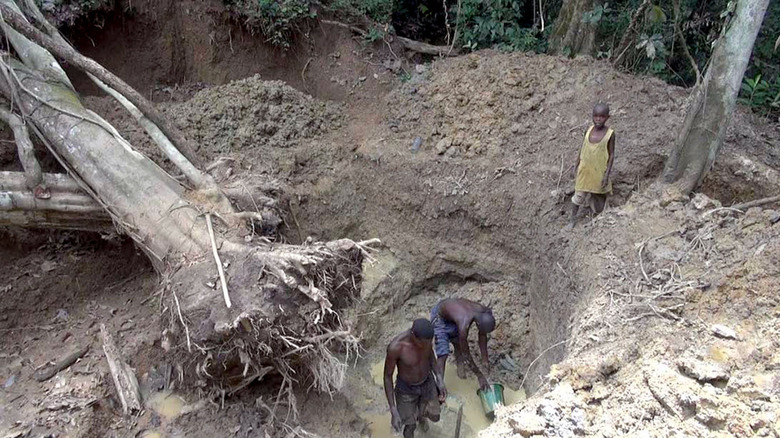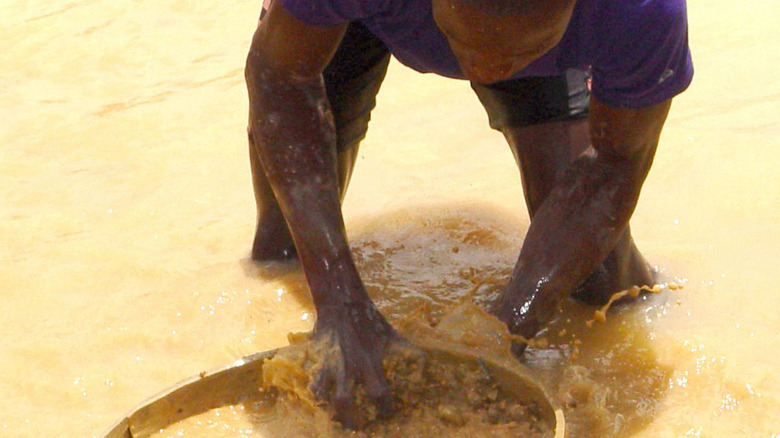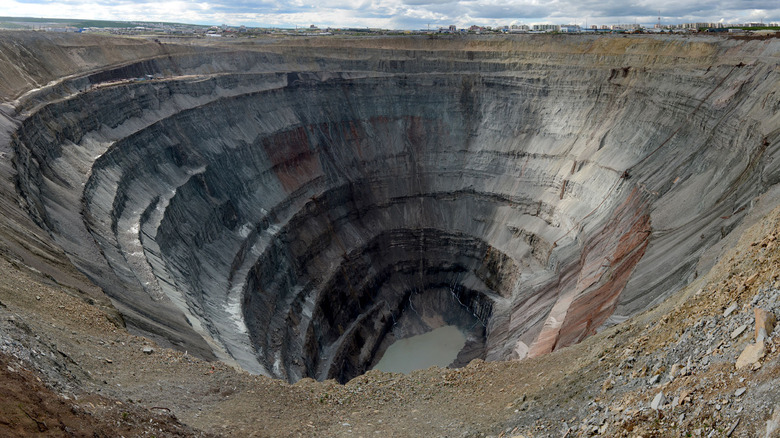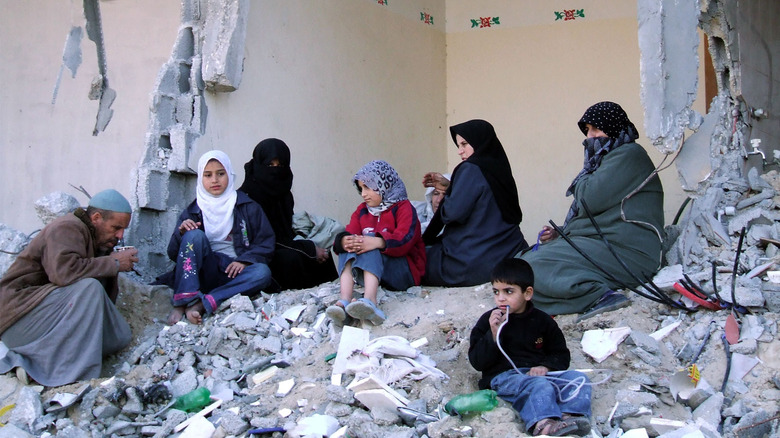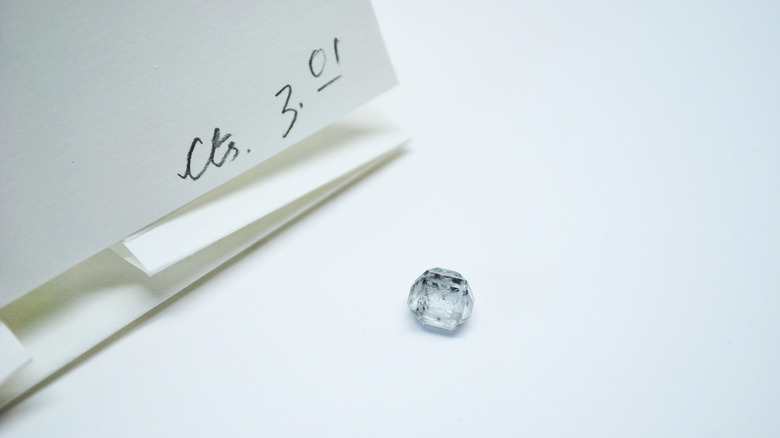Dark Secrets Of The Diamond Industry
Caution: The following article discusses human rights violations, genocide, and child abuse.
Built on a foundation of exploitation and human suffering, the diamond industry is deeply harmful in several more ways than most people might realize. From its roots in colonization to the human rights abuses inflicted on diamond miners and polishers to the ongoing violence that diamond sales finance, the diamond industry is built on the sweat and blood of the poor and disenfranchised. All so that people in wealthy nations can buy what are effectively little more than sparkly rocks. Even though many of these facts are open secrets, diamonds are still in high demand.
The diamond industry is a sprawling international network of mining, cutting and polishing, and trade. According to a 2021 report by Imperial College London, mining is the world's 5th largest industry, with gemstones making up a substantial amount of the resources mined from within the Earth. The most prolific diamond mines are found in Russia, Canada, and several countries in Sub-Saharan Africa. Combined, as a feature from Time reports, the diamond industry makes over $80 billion every year. Roughly 65% of the diamonds mined in the world come from Africa, but several diamond mines still rely on the systemic exploitation of workers, many of whom are children.
Much of this goes unspoken. When it is reported on, it tends to be glossed over. As the ethical diamond company MiaDonna notes, most jewelers don't know the history of the diamonds they sell and don't do enough to find out.
Diamonds weren't popular until the 20th century
Right now, in the early 21st century, diamond rings are inextricably tied to the idea of marriage proposals. Decades of pop culture, from Hollywood movies to children's cartoons, have taught entire generations of people that this is a time-honored tradition. The reality, however, is that this tradition began far more recently than most people realize, and it only exists because of a marketing campaign.
The idea of the "traditional" engagement ring is a popular myth, but the International Gem Society debunks it. This idea was fed into western culture in the 20th century in a bid to sell diamonds mined in Africa. The Washington Post elaborates further, pointing to 1947 as the time when diamond rings became linked with marriage. It originated with the diamond company De Beers and their slogan, "A Diamond is Forever." Nine years later, the phrase was further popularised by Ian Fleming's James Bond novel, Diamonds Are Forever. By the time the movie adaptation was released in 1971, the phrase was firmly lodged in humanity's collective consciousness.
It may be surprising to realize that the idea of saving up two months of salary to buy an engagement ring came from an advertising campaign, but that's exactly what happened. An article by The Atlantic points out that in the 1930s, less than a century ago, most Americans never even considered buying diamond rings for marriage proposals.
The diamond industry is rooted in colonial exploitation
Diamond mining in Africa began under European colonial rule. The Cape Town Diamond Museum tells the story, beginning in 1867 when diamonds were first discovered in South Africa, in what was then known as the British Cape Colony. Over the following ten years, the world's supply of diamonds grew tenfold, mined around the town of Kimberley.
By the 1880s, Kimberley's mines produced around 95% of the world's diamonds, helping it eventually grow into the city it is today. Under a new class of mining capitalists, diamond mining became an entire industry. The British had abolished slavery in 1833, but the mining camps which housed the workers were still grim living conditions. Historian Martin Meredith told NPR how miners were kept in rudimentary conditions, deprived of any kind of family life. Many miners died, and Black workers, in particular, were considered a cheap and expendable supply of labor.
Elsewhere, things were even worse. Seeing the British exploiting their mines, other European powers tried to compete, including Germany's brutal colonial government, as historian Steven Press explains via Stanford News. For Germany, their colonial activity brought substantial economic gains but, for native Africans, it was nothing short of a horrifying dystopia. While scouring the land for diamonds, the German colonists committed genocide against the indigenous Nama and Herero people. Many died in concentration camps. Many more died mining in a harsh region of desert known ominously as "The Zone."
The world's largest diamond company has a history of corruption
The first diamond mines in South Africa were dug on a farm, as Britannica explains, owned by the brothers Nicolaas and Diederick de Beer. Their two mines, known as the Kimberley and the De Beers, were once the most productive in the world. This led to the formation of the company, De Beers Consolidated Mines Ltd which was quickly sold to the newly formed London Diamond Syndicate. Now known simply as De Beers S.A., this company still markets around 40% of the world's diamonds, operating in over 20 countries on every continent except Antarctica.
De Beers, however, has been involved in no small amount of shady behavior. As Reuters reports, their secretive business practices have seen them compared to a cartel, criticized for benefiting from colonialism and South Africa's oppressive Apartheid government in the 20th century, continuing to rely on cheap labor for profit despite officially opposing the government's racial policies.
1996 saw De Beers banned from operating in the U.S. over a price-fixing dispute but, according to the UAB Institute for Human Rights, this company also has blood on its hands. De Beers' most egregious acts have involved buying diamonds from war-torn regions in Africa. In the 1990s, De Beers bought a billion dollars worth of these diamonds. Known as conflict diamonds or, more commonly, blood diamonds, these sales fund violence and abuse. This problem was brought to light around the turn of the 21st century.
Blood diamonds are still traded
While the term "blood diamonds" is now well known across the world, an alarming number of diamonds still fund military conflict and even those which don't can involve severe human rights abuses. One such place, as Human Rights Watch notes, is the Marange diamond field in Zimbabwe. In 2018, state-owned diamond companies, such as the Zimbabwe Consolidated Diamond Company, looted the revenue from the diamond mines. Villagers, who already felt harassed by the authorities, responded with a protest. They were met with brutal police response, with tear gas and live ammunition. Among those requiring medical care were three children. As New Zimbabwe reports, things are not much better in 2022, with Marange diamonds being sold worldwide. The U.S. banned the sale of Marange diamonds in 2019, per MiaDonna, but it's likely that many are still unknowingly worn on American fingers.
The trouble is, this is a systemic problem in many countries, even without conflict. An article by Time discusses the hardships faced by a Congolese diamond miner named Mbuyi, caught in a situation with no real choice but to dig for diamonds. The work may be back-breaking but, for people like Mbuyi, it's the only way to buy food and medicine to support their families. There are only two options: risking death in unsafe mines, or slow starvation. The most alarming thing, however, is that Mbuyi was 15 when Time spoke with him. When he first began mining, he was only 12.
The diamond industry relies on child labor
In 2020, schools across the world closed due to the coronavirus pandemic. For most children, this simply meant learning from home, but for a lot of children in the Central African Republic, it meant going to work in the mines. Reuters reports that child labor in mines increased by 50% after schools were ordered to close. In the CAR, it's illegal to hire child workers, and punishments can include fines and up to three years in prison. But these laws are enforced poorly, if at all. Right now, it's impossible to know how many children are working in the mines of the CAR, many of which are controlled by militias.
This disturbing practice is, sadly, nothing new. A 2009 report by the International Human Rights Clinic at Harvard Law School details the many human rights violations committed against child workers in Sierra Leone. At the time of the report, the so-called artisanal diamond mines of Sierra Leone were the largest contributor to the country's overall GDP, but the child miners would earn only 15 to 60 cents a day if they didn't have a contract. Contracted child laborers' earnings could not exceed $2.10 per day. Things were no better in 2019 when Borgen Project reported that 72% of the country's children, aged 5 to 14, were affected by child labor.
Mines aren't the only part of the diamond industry to employ children for labor. As the Times Of India reports, children aged 14-17 are also put to work cutting and polishing diamonds.
The Kimberley process is not stopping the blood diamond trade
In 2003, as Time reported, the diamond industry took steps to curb the trade in blood diamonds. Known as the Kimberley process, named after the South African city, it was intended to provide a way for buyers to be certain that the diamonds they were purchasing would be untainted by violence. Unfortunately, the Kimberley process suffers from having too many loopholes and exceptions to be effective. The disappointing result is that the global diamond market is still full of gemstones either mined in war zones or otherwise collected by exploiting vulnerable people.
A central problem is that the definitions used in the Kimberley process are too narrow. It defines conflict diamonds as any gemstone sold to fund rebel militias trying to overthrow a state government. Plenty of diamonds are still linked to conflict without meeting this definition. The diamonds which help to fund the Zimbabwean army, for example, aren't considered conflict diamonds despite the atrocities that the army committed against the miners. Notably, Zimbabwe is the vice-chair of the Kimberley process in 2022.
So egregious are the problems in the Kimberley process that, in 2011, BBC News reported that the human rights organization Global Witness abandoned it as a lost cause. This serves as a damning indictment, considering Global Witness was instrumental in putting the process into place. Clearly, better protocols are required, but there are currently no plans to create any.
Diamonds help to fund the Russian government
In 2022, almost a third of the world's diamonds come from Russia. According to Business Insider, around 90% of those are mined by the company, Alarosa. A hefty cut of the profits directly funds the Russian state. As Forbes reports, a third of Alarosa is owned by the Russian government, and another third is owned by the Russian republic of Sakha, where the company is based. Following Russia's invasion of Ukraine in 2022, the U.S. imposed sanctions to curb Russia's diamond profits, but with little effect. This led to Russian diamonds being banned by the U.S.
The Russian diamond industry, however, also has interests outside Russia. It holds a relationship with the Central African Republic. In 2022, according to MiaDonna, Russia was trying to lift Kimberley process sanctions prohibiting the sale of CAR blood diamonds. Russia also has military interests in the CAR, with Russian mercenaries training soldiers there. As The New York Times reported in 2020, Russia's involvement was to assist the CAR's military in retaking its diamond mines from rebel forces.
Diamond mining is horrifying for the environment
Any kind of mining carries a significant environmental impact, permanently scarring the landscape, and diamond mining is no exception. Of the many diamond mines in the world, the most damaging are the large open-pit mines. Among the largest of these, as Times Now reports, is the Mirny diamond mine in Siberia. A yawning hole, nearly a mile in diameter, it's the second-largest human-made pit in the world, deep enough that its air currents can suck in helicopters. Around this hollow in the Earth is the mining town of Mirny with its population of around 40 thousand people, most of whom work for the Russian mining company Alarosa.
As MIT explains, open pit mining causes severe damage to the environment, particularly when the minerals being extracted are only found in small quantities, as gemstones typically are. The rarer the mineral, the more rock needs to be excavated in the mining process. This can release numerous health hazards, including asbestos-like minerals, toxic heavy metals, and radioactivity. These can be carried by mining slurries and run-offs, making them highly toxic and, without proper containment, potentially contaminating surrounding bedrock.
According to Imperial College London, diamond mining also impacts wildlife, causing deforestation, soil erosion, and the destruction of ecosystems. Chemicals used in mining can also pollute the air and contaminate both surface water and groundwater. A high price for a resource primarily used for aesthetic value.
Diamonds fund Israel's human rights abuses
The Israeli Diamond Industry boasts that it's one of the world's leading hubs in the global diamond trade, citing its origins in the Palestine Diamond Club, formed in 1937. However, according to the U.S. Department of State, the state of Israel didn't exist until 1948. The formerly Palestinian diamond industry now contributes roughly $800 million to the economy of Israel every year.
Israel is not known for treating the Palestinian people kindly. In 2021, Human Rights Watch condemned the Israeli government's abusive treatment of Palestinians as committing crimes against humanity. Their practices of forced segregation and relocation have been labeled as apartheid. This brutality is largely funded by the diamond trade. As Middle East Monitor reports, the Israel Defence Forces (IDF), known to attack civilian families in Gaza, receive 88% of their budget from the diamond trade. Another failure of the Kimberley process is that it only covers violence in the mining sector.
There are no diamond mines in Israel itself and, as Inside Arabia discusses, the Israeli Diamond Industry may have ties to blood diamonds mined in other countries. While the state insists that all of its diamonds are "conflict free," the inability of the Kimberley process to prevent human rights abuses means that such a guarantee is impossible. What's more, as Haaretz reports, there's a huge loophole in the U.S.'s 2022 sanctions against Russia. Russian diamonds can easily end up in America, as long as they're polished in Israel.
Diamonds are not actually rare
One of the oldest secrets of the diamond industry is the fact that diamonds are not as rare as most people believe. This idea goes all the way back to the British colonization of Africa, as Stanford News explains. It came from a false narrative, created as a marketing ploy to drive demand for diamonds. Somehow, this idea has never quite gone away. But it's all a lie.
The International Gem Society elaborates, explaining that, while all gemstones are relatively rare, diamonds are actually among the most abundant among them. They may even be the most common variety of naturally occurring gemstones. There's no reason why diamonds should hold any special place among the other, rarer ones. While this may mean that diamonds are artificially expensive, they're not even the most expensive kind of gemstone in the world today. Rubies, for example, are often being valued more highly.
Scientifically speaking, the fact that diamonds are so abundant isn't particularly surprising. Chemically, they're far simpler than other gemstones, being nothing but pure carbon, the 4th most abundant element in the Universe, per Science Notes. Geologists estimate that Earth's crust contains an incredible amount of diamond — a quadrillion tons of it, according to a new report from National Geographic -– that's several thousand times the mass of Mount Everest!
Synthetic laboratory diamonds are identical to natural diamonds
In the early 21st century, a delegate at a diamond conference was threatened with assassination. That delegate was Bryant Linares, CEO of a company named Apollo which specializes in synthetic diamonds. Smithsonian Magazine recounts this story, as it explains that synthetic diamonds have been practically indistinguishable from their naturally occurring cousins since 2008. It's one of the diamond industry's longest-standing myths that lab-grown diamonds are somehow inferior to those mined from the Earth. This is another lie.
As nothing but pure, crystalline carbon, all high-quality diamonds are chemically identical. Since 2008, methods for creating synthetic diamonds have only improved. The most expensive mined diamonds are completely flawless, but the same is true of lab-grown diamonds. As a PhysOrg press release notes, even the most sophisticated analysis techniques in the world cannot distinguish a flawless natural diamond from a flawless synthetic diamond. They're exactly the same.
While the diamonds mined from the Earth are formed under incredibly high pressures, different methods can be used to create them synthetically. A common technique is known as chemical vapor deposition (CVD), as described by the Gemological Institute of America, which effectively assembles diamonds from a gas of carbon atoms. Relatively cheap to produce, CVD diamonds are already available on the market. Even if diamonds are forever, the violence of the diamond industry doesn't need to be.


